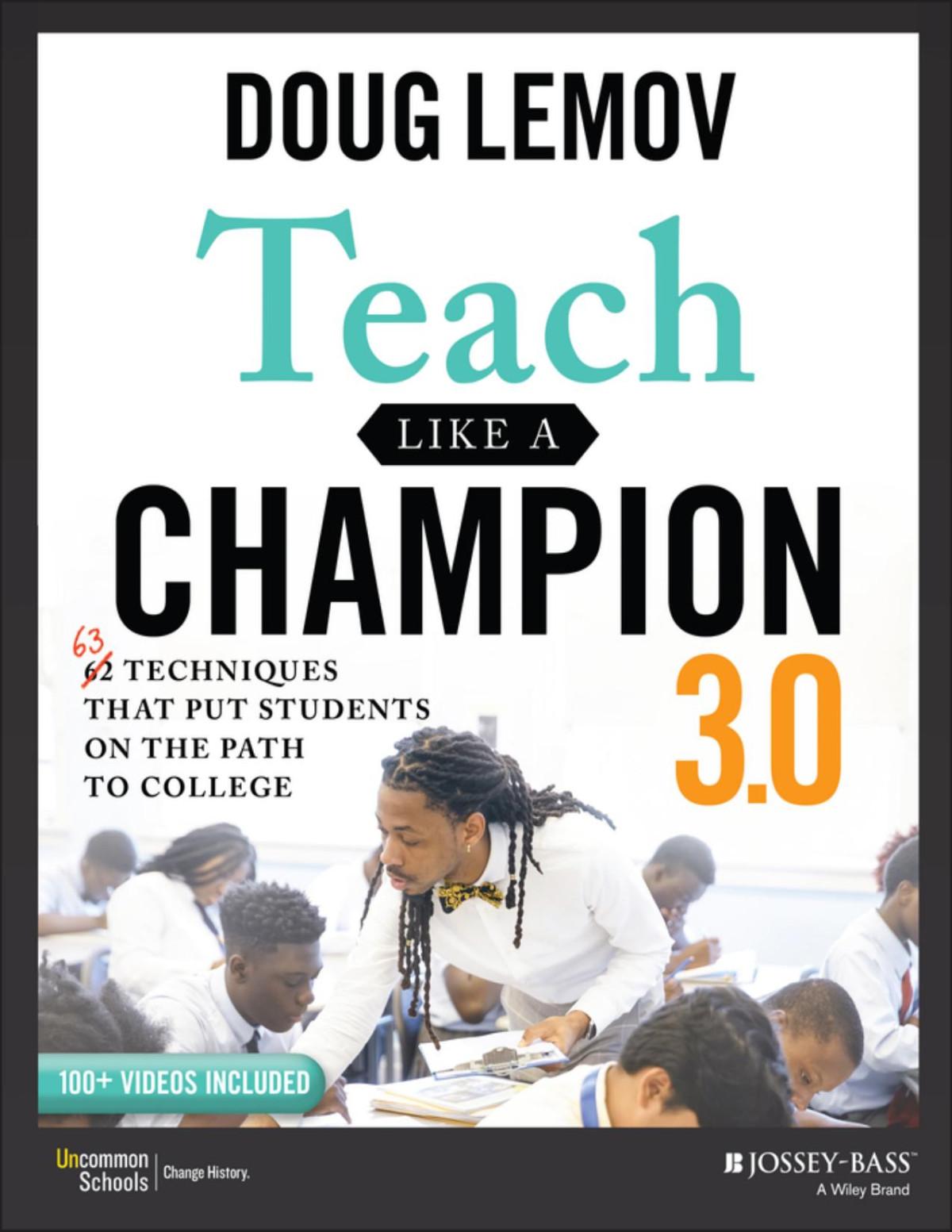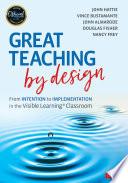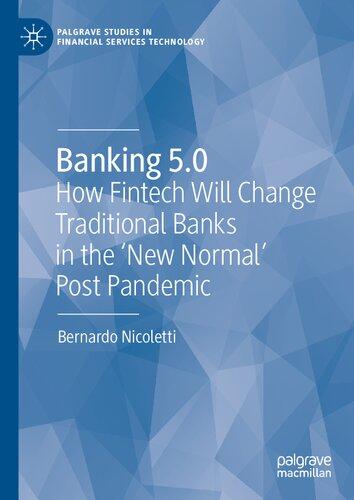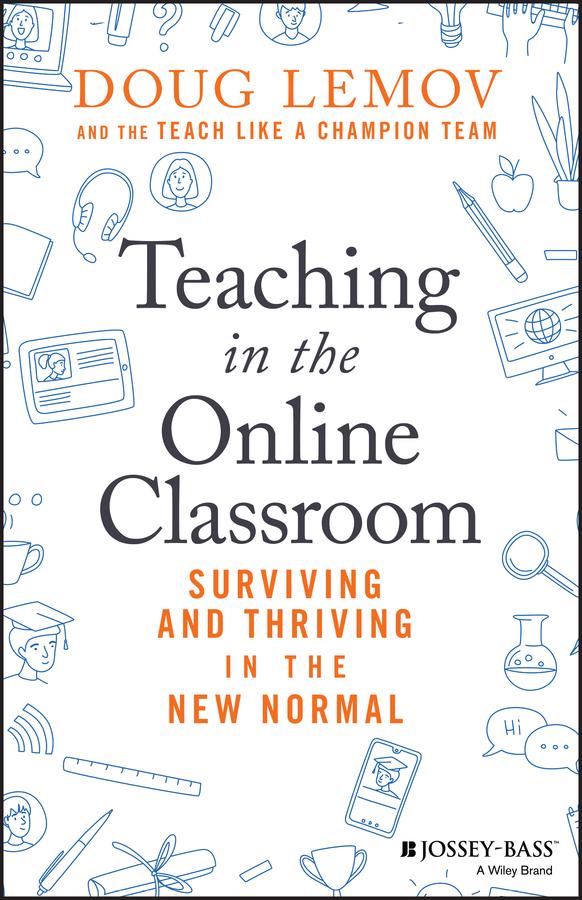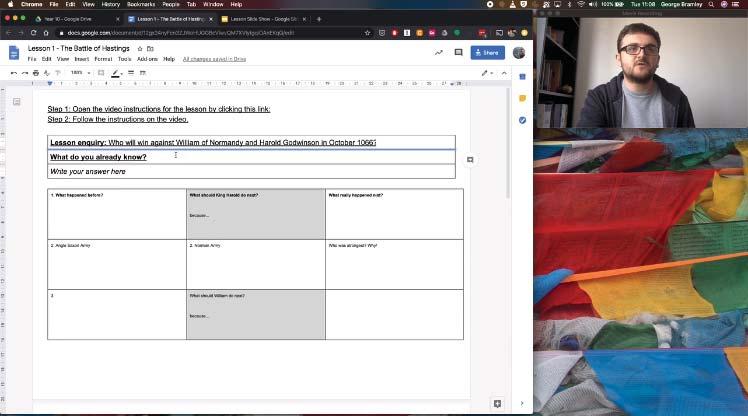RemoteTeachingandtheNewNormal
DougLemovandEricaWoolway
Thereareafewtiny,beautifulmomentsinoneofEricSnider’s remoteEnglishlessonswithhisstudentsatAchievement FirstIluminarMayoralAcademyMiddleSchoolinCranston, RhodeIsland.TheclassisreadingRitaWilliams-Garcia’s One CrazySummer,andEricasksifanyoneiswillingtotryto answeraquestionthattheyknowisdifficult.Erichasalready toldthem,calmlyandwithoutjudgment,thatmanyofthem misunderstoodakeypassage—thatthequestionthey’ve beenaskedtoanswerisahardone.Manyofthestudents areundaunted,andtheyvolunteer.“Thanks,James.Thanks, George.Thanks,Jaylee,”hesaysaseachhandisraised.He’s
showingstudentsthatheseesthemembracethechallenge. Soon,therearemorevolunteers.“Wow,tonofhandshere.I appreciateit.”
It’sagreatmoment,becauseitremindsushowimportant itisforpeopletofeelseen.Tellingsomeonehowmuchyou appreciatewhattheydointhefaceofchallengescanhelpbring outtheirbest,onlineasmuchasinperson.
Thismomentalsoremindsusthattheactofobserving otherscaninfluencepeople’sbehavior.Webecome—orcan become—morelikewhatwechoosetoobserve.“Thehuman bodyhasabout11Msensoryreceptors,”JamesClearwritesin AtomicHabits.“Approximately10Mofthosearededicatedto sight ... asmallchangeinwhatyouseecanleadtoabigshift inwhatyoudo.”Goodmodelsarepowerful.
Theclipends,asyouwilllatersee,withastudentansweringthedifficultquestionbeautifullyandcompellingly,from thebackseatofherfamily’scar.It’sadifficultworldrightnow, butshe’smanagedtoadapt,andshe’sbroughtherAgame.
Teachers,too,havebeenaskedtodowhattheyknowisdifficult:toshift,withoutwarning,toanunfamiliaruniverse—one whereweinteractwithourstudentsremotely,asifthrougha tinykeyholeintheclassroomdoor.Eachoftheyoungpeople wecareaboutnowappearsasasmallimageinthecornerof ourcomputerscreen(sometimesnoteventhat).
Nearlyeverythingaboutteachinghaschangedforteachers overthepastfewmonthsexceptthefactthatstudentsneed us.Andsoit’sincumbentuponusaprofessiontolearn newmethodstoreachthemasquicklyandeffectivelyas possible.
Thisbookisaboutapplyingthelessonsofthatmoment fromEric’sclassroomtoteachers.Initwe’llshowyou,with appreciation,tinymomentsfromtheclassesofrealteachers
workingonline.We’llshareinsightsanddiscussprinciples fromthoseexamplestohelpyouadaptassuccessfullyas possibletoour“NewNormal”ofremoteteachingorsome combinationofremoteandclassroomeducation.Andin doingsowehopetoshowourappreciationforyouandforthe teacherswhoseworkweshare.
Nooneaskedfortheworldtochangethisway,butithas. Asteachers,thatmeansthere’sworktobedone.Ifyou’rereadingthis,yourealizeandembracethatfact.We’regratefulto you,andourgoalistopayyoubackforthatcommitment.And thegoodnewsisthatit’snotjustthatteachershavejumped in,inthefaceofdifficulty,anddonethework.It’sthatthey havedonetheworkandbeguntofindsolutionstothedifficult day-to-daychallengesofremoteteaching.Wheneverdifficulty presentsitself,thereisalwayssometeacher,somewhere,who findsasolution.
FACINGTHENEWNORMAL,NOW.
Infacingnewteachingchallenges,it’simportanttoremember thatwhilesomuchoftheworkhaschanged(weallnowknow whatZoomis,forexample),muchalsoremainsthesame.The fundamentalsofteachingandtherelationshipsthatweknow fromourpreviouslivesstillverymuchapply.Sometimeswe justhavetolookharderorindifferentplacestoseeit.As onefrienddescribedherlifeunderquarantine,itisaNew Normal—totallydifferentbutwithatleastanechoofthe familiar.
SincethisNewNormalbegan,we’vewitnessedplentyof challengesinthe“classroom”—glitchyinternet;goodinternetbutsomechildrenlackingadevicetoaccessit;students participatingfromhallwaysoutsidetheirapartments;teachers
leadingclasseswiththeirownchildrenintheirlaps—butwe haveseenevenmoreofacan-doattitude,aproblem-solving embraceofsituationsoutsideourcontrol.Thereislesslookingbackovershouldersandmoreturningtofacethefuture full-on.
It’simportanttounderscoretheurgencyofthisattitude— theabsolutenecessityofgettingbetteratwhatwedonow,no matterthecircumstances.
Arecentblogpost1 byBrownUniversityeconomist EmilyOsteruseddatafromhercolleagueJohnFreidman’s researchtoshowhowcriticalthenextmonthsandyearsof ourteachingliveswillbe.Friedmantookdataonstudent progressfromtheonlinemathplatformZearn,chartedit longitudinally,anddisaggregateditbyincomelevel.Here’sthe chart:
Student Progress in Zearn, by School-Area Income Level For Classrooms Using Zearn BEFORE the Shutdown
Thedataarebasedontherateatwhichstudentswhowere alreadyfamiliarwithonlinelearningprogressedthrough achievement“badges”onZearn’splatform.It’sanimperfect
measure—ononehand,alotoftheworkinvolvesself-study ofpreproducedmaterials(asynchronouslearning)ratherthan face-to-faceremoteinteractionswithateacher(synchronous learning);ontheotherhand,it’sdataonstudentswhowere alreadydoingextensiveremotework,andthereforestudents forwhomtransitioningonlinewasprobablyfarlessofa disruptionthanithasbeenforothers.Badgesmaynotbe aperfectmeasureoflearning,buttheyofferdatathatshows usveryclearlyhowbeingawayfromclassroomshasaffected alargegroupofstudentsinameasurableway—andallowed ustodisaggregatethatdatabyincomeandlookforpotentialdisparitiesandinequities.Bythosestandards,thedata aredevastating.
“Evenforstudentsinthe best-off districts—thehigherincomeones—thereisareductionofabout10%inthe badgesearned,”Osterwrote,“andthisseemstogeteven worseinthemostrecentweeks.Forstudentsinmiddle-and lower-incomeschooldistricts,theresultsareadisaster.There appearstobeabouta60%dropinbadgesearned.Thatis, kidsinthesedistrictsaremovingthroughthecurriculum at lessthanhalfthepacetheydidwhileinschool”(italicsin original).
Thesituationisurgent,butwethinkthebigissuesare addressednotinsignificantlybyourwillingnesstofocuson “small”issuesofcraft—toimprovewhatwedoeverydayas teachers.
And,attheendoftheday,therearesomesilverlinings.A fewthingswillworkbetteronline;somestudentswillthrive morethere;somethingswe’lllearnwillmakeusbetterteachers inallsettings.Therewillbesomelessonstotakebacktoour oldclassrooms.Wedon’tmeantoignorethat.Wejustthinkit’s importanttobeclearthateverythingweknowaboutteaching
suggeststhatonnettheexperienceonlinewillbelesspowerful, andwhat’smostworrisomeisthatitwillalmostcertainlybe thatwaymostforthestudentsmostatriskalready. It’sallhandsondeck.
Acolleague,ajournalist,wrotetousinthemidstofthe quarantinelastApril.Whatdidwethinkwastheconsensus feelingofteachers?Weretheyexcited?Didtheythinkthe futurehadsuddenlyarrivedasinaday?Orweretheymore cynical?Weretheythinking, notanotherdamnthingtoget trainedon!?
Noneoftheabove.Wethoughtadecentsummaryofthe averageteacher’sopinionwas:“Thisisscary,andImissthe worldasitusedtobe—me,myclassroom,mystudents.But thisisreality.Thekidsneedmetobegoodatthis,soI’vegot togiveitmybest.”
Obviously,nolargegroupofpeoplehaveopinionsthatare soeasilyglossed,butthisbookisforthoseteacherswho,like us,wouldnothavechosenthiscoursebutwho,facedwithit, aredeterminedtofindsimple,replicablewaystodoitwell andserveourstudentsbest.Inotherwords,we’renofuturists. Wewon’tbemakinganyTEDTalksontheseamless,frictionless,automaticteachingfuturewaitingforusifwecouldjust embracetechnology.
Likemany(most?all?)ofyou,wehopetobebackto classroomssoon.Wehavespentmuchofourcollective careersstudyingthem—eachtinyinteractionbyeachtiny interaction—becausewethinktheymattersomuch,and becausewethinkthatclassroomsareuniquelysuitedtobuilda culturearoundstudentsthatbringsouttheirbest.Classrooms canbea“brightmirror”:aplacethatwrapsstudentsina culturethatdrawsoutthebestfromwithinthem,butalso changesthemforthebetter.Theideallearningenvironment
isaclassroomwhereyourpeerslookatyouasyousharea nascentidea.Theireyesshowtheyvalueittoo.Theylisten carefullyandtheirwords,inresponse,makethepointaswell. Theyhelpyouexpandandrefineit.Soonit’snotreallyyour ideaanymore,butthegroup’scollectivethinking.Together, youcometoadeepersharedunderstanding.
Humansarefinelyevolvedmachinesforobservingand respondingtotheotherhumansaroundthem,havingsurvivedasaspeciesbyformingsocialgroups.Whenweare togethersocially,wecandrawonallofthetoolsthatarewired inourbrainsthatmakeusrespondtopositiveculture.And whileanonlinesettingcan’tprovideallthethingsaclassroom can—youcannevercapturethefeeling,forinstance,ofa roomof30peoplehangingononeanother’swords,somehow actuallyfeelingtheirresponsestoatellinginsight—thegoal mustbetogetremotelearningasclosetothataspossible.It needstogetacrossthepoweroflisteningandbeingheard,the waystudentsaredrawninandcausedtobeengaged,ontheir toes,andaccountable,inthemostlovingsenseoftheword, evenwhentheymaynotfeellikeit.
Onnet,webelieve,theexperienceoflearningonlinewill likelybelessproductiveformoststudentsthanclassroomsare. Itmaybeprofoundlysoformany,andinawaythatimpacts themostvulnerablelearnersmost.It’sasortofsecond,educationalpandemic,andthebestwaytofightit,wethink,is byfocusingonthecoreofthecraft:thefoundationalmoves thatshapeeachinteractionwithyoungpeopleandthatcan improvetheexperienceandmitigateitslimitationsasmuch aspossible.Theword“fundamentals”isimportant.Weseekin onlineclassroomswhatwesoughtintheirbrick-and-mortar cousins:thatwhichisrelativelystraightforwardtodoandeasilyreplicated,andthatwhichcanbereusedandadaptedto
makethelearningexperiencericherforstudents.Thosethings aremostvaluableandmostworthyourtime.AndasChipand DanHeathremindusinoneofourfavoritebooksonchange management, Switch, thesizeofthesolutiondoesnotalways matchthesizeoftheproblem.Smallchangescanhaveprofoundeffects.We’vetriedtofocusonthathere.
Ultimately,we’repragmatistsaboutonlinelearning, informedbyadoseofskepticismandaprofoundbeliefin people,students,andteachers,allofwhichmaymakeus usefulguides.Buteventoourmostskepticalsides,it’snotall badnews.Thereareafewsilverlinings,too.We’llfindout newthingsaboutourselvesandgrowourabilitiestoteach online.We’lldiscusssomeofthoseinamoment.Butfirst,let ustakeastepbackandtellyoumoreabouthowwecameto writeabookaboutsomethingthat,justafewshortmonths ago,wasthefurthestthingfromourmind.
THECRAFTOFTEACHING
Thisisagoodtimetonotethatweareteachers,too,notjust inthesensethatwewriteaboutandstudyteaching,butinthe sensethatwespendmostofourtimeinroomswithgroupsof peoplewhowearetryingtohelplearnthings—inthiscasethe craftofteaching.
Wetoowerecaughtoffguardbythesuddenerasureofthe classroom.Wehadaspringfullofworkshopstodesignand runandsuddenlyonedayinMarchtheywereallcancelled. Wewondered,shouldwecloseupshop?Hunkerdownand waititout?Butteaching,andteachers,wereincrisis.Andin theendwebelievethatourstrengthasagroupliesinthegroup itself—ourabilitytolearntogether.Thisiswhatwe’dbeen doingfortenyears:gatheringtwiceaweektowatchvideo
ofteachersteaching,analyzingtheirmovesanddecisionsin thetiniestdetails,andlearningasmuchaswepossiblycould. Ifyouaskuswhatwedo,wesaywestudyteachers.Could weturnthatpoweronvirtualclassrooms?Afterall,oneof thefewadvantagesofvirtualclassroomsiseaseofrecording. Thevideohadtobeoutthere.Couldwewatchandstudyand learn?
Twodaysafterwecloseduptheofficeandwenthome, wegathered—viaZoom—towatchourfirstbatchofvideo ofonlineteaching.Itwasfromagroupofkindergarten andfirst-gradeteachersfromacharterschoolinBrooklyn. Havingwokenupinabravenewworld,theretheywere, smilingforchildrenwhoreallyneededtoseethemsmiling, andgivingtheirbestatteachingsightwordsandstory problemsfromtheirlivingroomsandkitchens.Theywere wonderful,allofthem,butonestoodoutinparticular. HernamewasRachelShin.Weallknewatoncetherewas somethingdoublyspecialthere.Hersmileandwarmth madeitfeellikeshewasstandingintheroomwithus. Herlessonwasasynchronous—prerecordedforstudents towatchlater—butitwasclearlydesignedtokeepstudentsactiveratherthanpassiveasparticipants.Shetold herstudentstopausethevideoandcompleteaproblem. Shetoldthemtoemailheranotherforhomeworkthat night. DissolvetheScreen,PausePoints,LaggingAssessment: theseareallideasyou’llreadaboutlater,andeachofthem emerged,aseverythingheredid,fromthestudyofteachers likeRachel.
Wepostedaquickarticleonourblogaboutwhatwe’d observed.Itwasthefirstofmany,becauseafterthatfirstday weagreedtoputeverythingonhold,tostartwatchingvideos togetherfivedaysaweek,tolearnasmuchaswecouldas
fastaswecouldandtoshareitoutwithteachersasoftenand directlyaswecouldmanage.
Atthispoint,thelastthingonourmindwasabook.Afew weekslater,wetentativelyofferedawebinarwithvideostudy andkeyteachingprinciples.Itwasfree,butwelimitedthe sizesowecouldbettermodeltheinteractivitieswewere talkingabout.Registrationfilledinminutes.Thiswetookasa signalaboutthescopeofthedemand,notsomuchthequality ofoursupply.Evenso,weredoubledourefforts.Wejust wantedtobeabletosharethingsofvalueandlearnmorein theprocess.
Atthesametime,wehadanotherproblem.Werealized wewouldsoonhavetotakeeverythingwedidinourtrainingworkandmoveitonline.We’dbeenusingZoomforyears torunourmeetingsandstudysessions,andwehadthought alotaboutwhatagoodonlineinteractionshouldlooklike. Embarrassingly,wewerenerdcityaboutthisandhadwritten protocolsandprocessestohelpusmakeeveryonlinemeeting asvaluableandproductiveaspossible.ButwewerealsoLuddites.Atfirst,mostofusweren’tsurewhataBreakoutRoom was,letalonehowtouseit.Therewerescreensharingissues. Wait,whichbuttonisit? Ifthatsoundslikeyouatonepoint too,well,knowthatyou’resafehere.
Inotherwords,whilewewerestudyingthetransitioninto onlinelearning,wewerealsotransitioningourownteaching thereinfitsandstarts.Thisturnedoutthebeablessing—we gotimmediateopportunitiestoapplythethingswewere seeinginclassrooms.Somethingsprovedbetterthanothers. Wefoundsometricksthathelped.Andwealsofoundthat therewerealotoftricksthatdidn’tworkbecausetheywere toocleverbyhalf(i.e.,theywerefancy,butdidn’tactually maketheclassthatmuchbetter)ortoocomplex.Doing
themdemandedtoomuchofourownworkingmemoryto manage—tryingtounpackthekeyscenefromthenovel, peeringintoourlaptops,andreadinginthefacesofour participantswhethertheywerewithus.Wemovedslowly butpersistentlyforward,anddecideditwasmorevaluableto spendourtimelearningtodomorebasicthingsreally,really wellthantodoflashythingsthatworkedjustokay.
Ourheadsweredown,sotospeak,focusingonthose tasks,whensuddenlywelookedupandnoticedthattraffic totheTeachLikeaChampion(TLAC)bloghadmultiplied.
Peoplesuddenlystartedwritingtoaskustospeakat(virtual) conferencesononlineteaching.Wetriedtodeflectbecausewe knewweweren’texperts— Wow,peoplemustreallybeatthe bottomofthebarrel —butinretrospect,maybethatwasthe point.Wewereeveryman—well,everyteacher—struggling withthischallenge,butwiththeblessingofalotofvideo towatchandaroomfullofteachingnerdstodissectit.We mightnotbeabletogiveyouatheoryononlinelearning, butwesurecouldcueupvideosofamazingteacherstostudy together.Later,afriendinpublishingcalledandsaid,“You reallyneedtothinkaboutabook.Thenewschoolyearis comingupfast.”First,welaughed.Thenwecried.(Wewere reallybusy.)Andthenwegotstarted.
ForallourtalkofbeingLuddites,ofmissingtheclassroom, andthrowingslightshadeattechnologyandonlinelearning (it’soutofoursystemnow,promise),wereallybelievethat we—allofus—cangetalotbetteratthisprettyquickly.If nothingelse,ourownexperiencesbothstudyingandusing theseideashaveshownusthat,andwe’lltrytosharesomeof thoseexperiencesofgettingitwrongandthengettingitright
throughoutthebook,andwehopethishelpstoleaveyoufeelingbothmotivatedandoptimistic.Itcanbedone—soitmust bedone.
Withallofthatinmind,here’swhat’sahead.
Chapter1,byHannahSolomonandBethVerrilli,describes akeydistinctionbetweentwotypesofonlineclasses,synchronousandasynchronous.Wedescribesomeoftheir strengthsandlimitationsandhowtoaddressthem.Wealso discusshowtheycanworkinsynergy—howagreatlesson mightincludeelementsofboth.
Chapter2,byJenRuganiandKevinGrijalva,describes “DissolvingtheScreen,”whichistosay,makingstudentsfeel moreconnected,remotely.Whilebuildingandsustaining relationshipsisanimportantpartofDissolvingtheScreen,it’s aboutmorethanthat.It’saboutdoingthosethingsthrough thecontentandthecraftofteaching—aboutmakingstudents feelconnectedthroughlearning.
Chapter3,byColleenDriggsandJaimieBrillante,discusses oneofthebiggestchallengesofonlinelearning:distraction. Studentsarefarfromus,andtheyareonscreens—asetting thatisengineeredtoofferconstantdistraction.Thischapter isreallyabouthow,inonlineteaching,halfofthedistraction battleisoftenwiringyourinteractionstomaximizeattention.
Chapter4,byHilaryLewisandBrittanyHargrove,isabout PausePoints—momentswhenyouaskstudentstobeengaged andactive.Wegetpracticalandshowvideoofresponsesto suchquestionsas:HowoftenshouldPausePointsforactive studentengagementoccur?Whatkindoftasksaremostvaluable?HowdoIdothemasynchronously?
Chapter5,byEmilyBadillo,JenRugani,andHannah Solomon,isaboutassessment—or,asweliketocallit, CheckingforUnderstanding.Ourstudentsarefaraway.
Wecannotlookovertheirshouldersattheirnotesortheir problemsets.HowandwhendoweattempttoCheckfor Understanding?
Chapter6,byDarrylWilliamsandDanCotton,isabout thefoundationaloperatingsystemsofanyclassroom:itsproceduresandroutines—bothstudentfacingandteacherfacing. Thethingswedomostoftenarethingsweshouldhavearight waytodo.Theyarethingsweshouldbeabletodosimply, quickly,andwithoutmuchthought,sowecanfocusonlearning.Thisisastrueonlineasoff.
Chapter7,byRobRichardandJohnCostello,isabouttechnologyandplatforms.Howcanwegetasmuchteachingvalue aswecanoutofbasictools?Whataresomesimplehacksto makeourlivessimplerwhenwe’reusingtechnology?Howfar shouldwego?Simplicityisourmotto.
OneofthefirstthingswenoticedaboutRachelShin’slesson,thatveryfirstday,washowitechoedphrasesandactions thatrecalledthefamiliarpastsheandherstudentshadshared. Wekeepthinkingthatwecanapplythatideainanticipation. Thatweshouldsetouttoplanwhatwedoinourreturnto brick-and-mortarclassroomstoalignwithwhatwedoonline sotheyechooneanotherandsowecanmoveeasilybackand forthbetweenthemgoingforward,asuncertaintywillalmost assuredlyrequireofus.
Inlightofallofthis,weendwithafinalreflectiononthe futureandwhatitmaybring.Thatshouldproveuseful—at leasttothedegreethatit’susefultotakeadviceaboutthe futurefrompeoplewho,hereandnow,mostlycan’tfindtheir carkeys.
Kiddingaside(we’vegotthekeysnow!)ourgoalsare twofold:1)tohighlightusefulthingsinsmallmomentsin thelivesofrealteacherssoyoucanmakesmalladaptations
tohowyouteachonline,and2)toshowourappreciationfor teacherswhohavebeenaskedtodoimmenselychallenging workinthefaceofimmenseuncertainty,andknowtheymust doitwell.
Thankstoallofyouforyourworkonbehalfofstudents.It isthemostimportantworkintheworld.
SynchronousandAsynchronousLearning
HannahSolomonandBethVerrilli
Notallremotelessonsarethesame,butingeneral,remote learningtakestwoforms:asynchronouslearningand synchronouslearning.
Asynchronouslearninghappenswhentheworkoflearningoccursatdifferenttimesandindifferentplaces—say,when yourstudentsfillinagraphicorganizeryou’vepostedonline andemailitbacktoyou,orwhenyouvideotapealecturefor yourstudentstowatchontheirowntime.Synchronouslearningisthekindthathappensatthesametime,butindifferent places.AnykindofclassthattakesplaceoverZoom,Google Meet,oranynumberofplatformsqualifies.
Eachtypeofremoteinstructionhasitsbenefitsandlimitations.Inthischapter,we’lllookateach,andofferafewwaysto getthemostoutofboth.
ASYNCHRONOUSLEARNING:BENEFITS ANDLIMITATIONS
IfsynchronouslessonsareliveTV,asynchronouslessonsare Netflix(or,moreaccurately,YouTube).Withthatdifference comesallthebenefitsofhavingcontroloverthefinalproduct.Sinceteacherscanrefilmoreditavideowhentheyfind theywanttoimprovesometurnofphrase,orwaittobegintapinguntiltheirownchildrenarenapping,asynchronouslessons canproduceahigher-qualitypresentation.
Students,too,haveabitmorecontrolinanasynchronous setting.Maybetheyneedtowaituntilasiblingisfinishedwith asharedlaptop,orloginaroundtheirfamily’sworkschedules (ortheirown,inthecaseofahighschoolstudent).Theycan alsowatchasynchronouslessonsattheirownpace,pausing whentheyneedmoretimetocompleteaquestion,orrolling backtohearanexplanationasecondtime.
Asynchronouslessonsarealsoscalable:oneteachercan tapealessonthatmultipleteacherscanuse,dividingthe contentworkloadamongstaffandfreeingteachersupfor othertasks.Andasynchronouslearninglendsitselftomore complexassignments,sincestudentscantakethetimeto bemorereflectiveandtoputmoresustainedthoughtinto theirwork.
We’veseenmanydifferentwaysasynchronouslessonscan supportstudentlearning.Studentsmightwatchahistory lectureasynchronously,thenusetheinformationtoanswer awritingpromptoffline.Mathscholarscouldwatchtheir
teacherdemonstratehowtofindtheaverageofaseriesof numbers,thenmovetopracticeproblems.Asynchronous lessonsallowteacherstoplaywithtime,too.Lessonscanhave an“expirationdate”orbe“evergreen.”
Expiration-datelessonsaredesignedtobewatchedwithin aspecifictimeframe—asnarrowasafewhoursorasbroadas severaldaysormore.Assigningdeadlinesisthemostcommon approach(“Watchthelessonanduploadtheaccompanying HWpacketbeforeWednesdayatnoon,”or“Watchthelesson, completetheproblemset,andemailittome.WhenIgetit,I’ll sendyoupart2!”),thoughteachersmayalsoexperimentwith referringtospecificworldorcommunityeventstobindlessons toaspecificpointintime.Basingavocabularylessonarounda classbirthday,forexample,orselectingnewsarticlestosupplementnovelstudycouldbeincludedinexpiration-datelessons. Thesetypesoflessonsareespeciallyhelpfulinestablishingand reinforcingresponsibleworkhabitsinstudentsandinbuilding astrongsenseofcommunity.
Unlikelessonswithanexpirationdate,“evergreen”lessons liveforeverandstudentscanwatchthemwhenevertheyneed to.Forexample,ateachermightrecordaquickvideoonincorporatingcitationsfromaprimarysourceifstudentsneeda refresherbeforeend-of-unitessays,orsimplycapturealesson aboutthree-dimensionalprismcrosssectionswithoutspecifyingwhenorhowmanytimestowatchit.Studentsmightwatch anasynchronouslytapedscienceexperimentseveraltimes.
Theinternet,too,isfullofevergreenvideos—famous authorsreadingtheirtextsaloud,BillNyepresentingscientific concepts,andKhanAcademycoursework—whichteachers canusetocreateabankofhelpfulvideocontent.Wethinkasa rulethatevergreenvideosshouldbeshortandpithy,andused primarilyforreference,homework,orasintroductionstonew
content(ideallyfollowedupbyavideowithclearerstudent accountabilityandcommunity).Thoughitmaybetempting toimaginerecordingonevideotointroducepolynomials everyyear,studentattentionandengagementmaydecrease withoutthosepersonalandtimelytouchpoints.
Asynchronouslearninghasitsdownsides,too.Forteachers, withouttheabilitytoassesstheengagementorunderstanding oftheirstudents,eventhestrongestasynchronouslessoncan feelliketeachingintoavoid.Andthepressuretomakethe asynchronous“perfect”mighttranslateintohoursofrefilming.
Ontheothersideofthescreen,studentsmayloseasenseof connectednesstoteachersandpeers—andfeellittleaccountabilityduringasynchronouslearning.Wefearthatstudents maywatchandpolitelyignorealloftherequeststo“Stopand Jot,”“addthistoyournotes,”or“completethisproblem,”and insteadwaitfortheteachertofeedthemtherightansweras thecamerarolls.Ortheymightindustriouslycompleteevery taskbutemergenothavingmasteredmuch—andwithout ourknowingit.Withoutsomecomponentofsynchronicity oraccountability,thereisnowayofknowingifstudentsare engagedatall.Theymaypressplayonthevideo,doodleon theirpaperwhilemunchingasnack,andthenworkonthe assignmentasifthey’dneverseenit.
Forthesekindsofengagementchallenges,historyteacher GeorgeBramleyfromBrigshawHighSchoolinLeeds,England,sharedanelegantsolution.Georgerequiresstudents tohavealesson-specificGoogleDocopenastheywatchhis prerecordedlecture.Throughoutthelesson,heasksstudents tojotdowntime-specificnotesandanswers.Becausehis questionsaresetuptobeembeddedwithinthecontentasitis explained(e.g.“Whathappenedbefore?”“WhatshouldKing
Harolddonext?”“Whatreallydidhappennext?”)andare formativeinnature,studentscan’tsimplyfillinthechartafter half-listening.Georgecantellhowattentivestudentswere throughoutandassesstheirlastingtakeawaysafterthevideo hasended.
Georgealso“checksin”withstudentsduringthisasynchronouslessonbyremindingstudentswheretheyshould beandwhattheyshouldbedoing:“Pleasemakesureyou aretakingnotesaboutthisinthatsecondrowofboxes,” and“YoucantypethisnextbitofinformationintoBox#5.” Georgemaynotbeintheroomwiththestudents,buthis thoughtfulsupportingdocumentandverbalremindersensure thatstudentsareprocessingtheinformationstepbystep, efficientlyandeffectively.
Thereisalsotheriskthatanasynchronouslessonmay haveasymmetricoutcomes:thestrongstudentscontinueto flourish;thestrugglingstudentscontinuetostruggle.Multiple factorscaninfluencethoseasymmetricoutcomes:theattentionspanoftheindividualstudent,howmuchthestudent perceivesthemselvestolikeor“begoodat”thesubject,the
preexistingrelationshipwiththeteacher,andofcoursethe abilityandavailabilityoffamilysupport.
ConsiderSarah,whowatchesherSpanishlessonwhileher threesiblingsrunaroundnearby;she’ssupposedtohelpwatch themwhilehermomisout.Amelia,ontheothersideoftown, sitsatthekitchenwithhermomnearby,keepingawarmbut watchfuleyeonherandhelpingherstayorganized.Whogets moreoutofthatlesson?
Asweknowfromyearsofmakingseatingchartsfor ourbrick-and-mortarclassrooms,whereyouarewhenyou arelearningcanmakeabigdifferenceontheoutcome.In watchingremotelearningfromaroundtheworld,we’veseen students“attend”virtualschoolwhilewearingpajamasinbed, whilebuckledinthebackofamovingcar,andwhileseated amongstsiblingsatacrowdedkitchentable.We’veseenhomes whereanadultoroldersiblingisabletositnearbyandrefocus astudent,andwe’vepeekedintolearningenvironmentswhere it’scleartheninthgraderissimultaneously“inalgebraclass” andmanaginghermuchyoungersiblings.
Bothwatchingavideoandcompletingasynchronouswork canrequireafairamountoffamilialsupport(andinternet bandwidth),whichweknowisparticularlychallengingfor allfamilies—andit’saparticularlyasynchronouschallenge. Inasynchronouslearning,studentsarelearninginwhatever circumstancestheymayfindthemselves—supportedor independent,confidentorinsecure.
Finally,toomuchscreentimecanincreasefatigueand decreaseattention.Thinkoftheseven-year-oldwhose second-gradeclassroomonceburstwithsongandprojects nowtryingtolearnmultiplicationfromtwo-dimensionalMs. Smith.Orthestudentwhosepull-outclassroomgaveherthe scaffoldingandsupportsheneededtosucceedinalgebraand
isnowonthesamevideoasallofherclassmates.Dwindling attentionspansandlackofengagementcanseemimpossible tomanageormonitoronline.Howdoweknowthedifference betweenvideorollinginthebackgroundandstudentsdoing thework?
Giventhedownsides,whyeventapeasynchronouslessons? WhynotjustsendkidstosomeeducationalcorneroftheinternetlikeKhanAcademywherethecontentisgoodandcomprehensiveandreadytoroll?Acoupleofreasons:connectionand engagement.
Thoughateacherfilminginherdiningroommaylack theslickpolishofpopularinternetfare,humanconnection withsomeonewhocaresaboutyouisindispensable.And engagement,accountability,andtaskclarityaren’tbakedinto videosnotpreparedwithourownstudents’learningoutcomes inmind.Thecontentofsomeoneelse’svideois“optional.” Itsimplydoesn’thavethestructureandsupport.Itdoesn’t remindkidswhenandwheretotakenotes,orrequirethemto solidifycontentbypausingtotryaproblem.
Weseebothofthese—theconnectionandthe engagement—inJoshuaHumphrey’sasynchronousmath classfromKIPPSt.LouisHighSchool.First,Joshuabreakshis dailymathinstructionintotwoshorterlessonsandprovides anassignmenttocompleteinbetween.Evenforadults,it’s hardtomaintainfocusafter60minutesormoreonaZoom call;bytrimminghislessonsandprovidinganapplication assignment,Humphreyhelpshisstudentspacetheirdays, increasingtheirchancesofattentivenessduringeachlesson. AndMr.Humphreykeptthislessontoaslim12minutes.Josh effectivelybreaksuptaskstohelphisstudentsmanagetheir cognitiveload,applyingandconsolidatingoneconcept,thus helpingtoencodeitinlong-termmemorybeforemovingto
another.Andhowmucheasieritisforstudentstoremainfully engagedwhentheyonlyhavetopracticetheself-disciplineof focusfor12minutesinsteadof40!
VideoClip1:JoshuaHumphrey https://vimeo.com/427340257
Next,asyoucanseeintheclip,Humphreymodelstwo techniquescriticaltobuildingstudentinvestmentinasynchronouslessons:hejumpsrightintothecontent,andhe makesthelearningpersonal.
Inonlinelearning,attentionisapreciouscommodity—not amomentshouldbewasted.Bykickingoffhisclasswitha clearobjective,Joshisablebothtokeepthewholelessonto under12minutesand,evenmoreimportantly,signaltostudentsthateachofthoseminutesisimportant.What’ssobrilliantabouthisapproach,though,isthatheusesthisDoNow toreinforcehisconnectionwithhisstudents—aconnection thatisgroundedinthelearningtheydotogether.Heshows hisfaceonthescreen,looksdirectlyatthecamera,anddelivers thedirectionswithEconomyofLanguage,warmth,andjusta touchofinformality.Whenherestatestheobjective“Soyou’ve gottatellmeaboutalltheparts[ofapolynomial],okay?What dotheymean?”inkid-friendlylanguage,itmakeshisstudents feelasthoughtheyarereallybackintheclassroomwithMr. Humphrey.HereinforcesthiswithhiswarmsmileashetransitionstotheDoNow:“Firstthingsfirst,justlikeinanyother [brick-and-mortar]class.”
Let’speekintoanothermathclasstoseesimilarparallels withyoungerkids.JustlikeJoshua,RachelShin,ofBrooklyn



